doi: 10.56294/ai2024145
ORIGINAL
Maryland Educational Unit Intervention Plan: Artificial Intelligence, ChatGPT, and Virtual Reality in Education
Plan de Intervención Unidad Educativa Maryland: Inteligencia Artificial, ChatGPT y Realidad Virtual en Educación
Karina Alejandra Rissone1, Mariana Arruabarrena Vittar1
1Universidad Siglo 21, Licenciatura en Educación. Argentina.
Cite as: Rissone KA, Arruabarrena Vittar M. Maryland Educational Unit Intervention Plan: Artificial Intelligence, ChatGPT, and Virtual Reality in Education. EthAIca. 2024; 3:145. https://doi.org/10.56294/ai2024145
Submitted: 28-11-2024 Revised: 12-12-2024 Accepted: 17-12-2024 Published: 01-01-2025
Editor: PhD.
Rubén
González Vallejo ![]()
ABSTRACT
This intervention plan will be implemented at the Maryland Educational Unit in Córdoba. Due to technological advances, teachers and students need to incorporate ICT into classroom learning, developing new skills that will help them stay at the forefront of their field. That is why we are proposing to develop a training project on educational innovation, providing tools and strategies such as artificial intelligence, aimed at primary school teachers, for the inclusion of new technologies in classroom practices during the 2024 school year. Six meetings will be held. In the first stage, an informative meeting will be held with the management team and then with the teachers. The first meeting will present the topic of artificial intelligence and its applications in education. The second meeting will introduce Chat GPT, and the third meeting will present virtual reality. The fourth meeting will present different platforms for exploring educational virtual reality content. This will be followed by a practical class. The last meeting will present additional resources and online communities for further exploration of these technologies. The meetings will be led by the external educational advisor. The institution’s resources will be used. It is hoped that, with these tools, teachers will acquire critical thinking, reflection, comparison and analysis skills for use in the school environment. These tools develop creativity and innovation, exploring multiple possibilities. The purchase of virtual reality glasses is recommended.
Keywords: Artificial Intelligence; Chat GPT; Virtual Reality.
RESUMEN
El presente plan de intervención se desarrollará en la Unidad Educativa Maryland de Córdoba, debido a los avances tecnológicos, los docentes y alumnos necesitan incorporar las TIC al aprendizaje en el aula, desarrollando nuevas habilidades que los ayuden a mantenerse a la vanguardia en el medio en el que se encuentran, por eso que se presenta la propuesta de desarrollar un proyecto de capacitación sobre la innovación educativa, brindando herramientas y estrategias como la inteligencia artificial, destinada a docentes de nivel primario, para la inclusión de las nuevas tecnologías en las prácticas áulicas durante el ciclo lectivo 2024. Se desarrollarán 6 encuentros, en una primera etapa se realizará la reunión informativa con el personal directivo y luego docentes. En el primer encuentro se presentará el tema, inteligencia artificial, sus aplicaciones en educación. En el segundo encuentro se introducirá en Chat GPT, durante el tercer encuentro se presentará la realidad virtual. En el cuarto encuentro se presentarán diferentes plataformas para explorar el contenido de realidad virtual educativo. Luego se realizará una clase práctica. En el último se presentarán recursos adicionales y comunidades en línea para seguir explorando estas tecnologías. Los encuentros serán dirigidos por la asesora pedagógica externa. Se utilizarán los recursos de la institución, Se espera que, con estas herramientas, los docentes adquieran la habilidad de pensamiento crítico, reflexión, comparación y análisis para utilizarse en el entorno escolar. Con estas herramientas se desarrolla la creatividad y la innovación, explorando múltiples posibilidades. Se sugiere la adquisición de lentes de realidad virtual.
Palabras clave: Inteligencia Artificial; Chat GPT; Realidad Virtual.
INTRODUCTION
Technology is currently advancing at a rapid pace, and education must not be left behind. That is why this project will focus on educational innovation and the use of artificial intelligence in schools. Specifically, it will address Chat GPT and virtual reality used in education.(1)
For this reason, the Maryland Educational Unit in the province of Córdoba sees a need for updating and training in new technologies, specifically at the primary level.
For this reason, the following general objective is proposed: To develop a training project on educational innovation, providing tools and strategies such as artificial intelligence, aimed at primary school teachers at the Maryland Educational Unit in Córdoba, for the inclusion of new technologies in classroom practices during the 2024 school year.
With this action plan, it is hoped that teachers will acquire the tools to improve educational quality, facilitate the representation of abstract concepts, and improve understanding. It will also enable them to practice skills in a safe and caring environment.(2,3)
That is why the structure of this final degree project is organized as follows:
Chapter I:
· Presentation of the thematic line: this work will address "Innovative learning models," which are strategies that improve teaching and learning strategies and facilitate communication in the classroom, make explanations more attractive, help to understand content clearly, facilitate the acquisition of knowledge, and reinforce learning.
· Summary of the institution: the Educational Unit of the Department of Colón, Province of Córdoba, which belongs to the private sector, has secondary, primary, and early childhood education, with two sections for each grade. The school's vision is to help students reach their full potential.
· Identification of the need: with technological advances in the current digital age, we are invited to rethink teaching models. To do this, teachers must incorporate ICTs into classroom learning to develop new skills that will allow them to be at the competitive forefront of today's world.
Chapter II:
· The overall objective: to develop a training project on educational innovation, providing tools and strategies such as artificial intelligence, aimed at primary school teachers at the Maryland Educational Unit in Córdoba, for the inclusion of new technologies in classroom practices during the 2024 school year.
· Justification: artificial intelligence (AI) is revolutionizing education with tools that personalize learning, provide instant feedback, and free up valuable teacher time to focus on student interaction. By adapting to each student's learning pace and style, AI helps identify and improve understanding of the material, ensuring that students achieve their maximum potential.
· Theoretical framework: this theoretical framework will be developed around topics related to: digital literacy, artificial intelligence in education, Chat GPT, virtual reality, etc.
Chapter III:
· The intervention plan will be developed in three stages. First, a meeting will be held with the management team, followed by a meeting with the teachers. In the second stage, there will be six meetings to provide teachers with the necessary tools. In the final stage, a joint evaluation will be carried out with the management team and teachers. The institution's resources will be utilized, given its computer room.
· Expected results: this intervention plan is expected to innovate teachers' pedagogical activities and encourage students to participate enthusiastically in school activities. Teachers will be trained and provided with tools such as ChatGPT, which serves as a content generator, task assistant, and personalized assistant. Additionally, they will have access to virtual reality, allowing them to immerse themselves in environments that facilitate interactive learning experiences. This will enable them to work effectively with students in the classroom, ultimately improving educational trajectories.
· Conclusion: it is claimed that the acquisition of Artificial Intelligence tools in the classroom will enhance students' skills, thereby improving the quality of education.
· Reference: this will be developed based on the bibliography that supports the action plan.
Chapter I
Presentation of the Thematic Line
This intervention plan will address the thematic line of "Innovative Learning Models"(1) at the Maryland Educational Unit, aligning with the current reality. It is necessary to address emerging trends in educational activities involving students, as this is crucial for continuous development and innovation.
Innovation in education involves a set of systematic and coherent changes to achieve transformation by adopting novel learning methods.
According to Carbonell(2), innovation is defined as: innovation is a series of interventions, decisions, and processes, with a certain degree of intentionality and systematization, that seek to modify attitudes, ideas, cultures, content, models, and pedagogical practices. And, in turn, to introduce, in a spirit of renewal, new projects and programs, curricular materials, teaching and learning strategies, didactic models, and other ways of organizing and managing the curriculum, the school, and classroom dynamics.
In the words of Fernández Navas:(3) educational innovation is a set of changes systematically introduced into educational practice, consistent with knowledge in different areas of education and with the goals expressed and shared by community members as a concept of improvement.
For Pierre Levy(4), cyberspace or the network is "the new medium of communication emerging from computers". In this sense, innovation in technological resources plays a leading role in 21st-century teaching.
According to Sánchez(5), digital educational resources are technological tools that facilitate communication, make explanations more attractive, aid in the understanding of content, simplify the acquisition of knowledge, and reinforce learning with more practical examples.
Summary of the Institution
General
Telephone: (38543) 432239/ 433629/ 435656
Website: www.maryland.edu.ar
Reference email: administración@maryland.edu.ar
The Maryland Educational Unit is a private secular institution located in the town of Villa Allende, in the province of Córdoba, in the department of Colón, at Güemes 702. Its focus is on communication and foreign languages.
The institution has a single school day, which is held in the morning, with an optional double school day, which is not compulsory, in English (F.O.L.I).(6)
History
The Maryland educational unit began operating in 1994, when a group of companies presented projects to the Villa Allende community. They aimed to establish an academic center where values and knowledge could be practiced and shared, offering the opportunity to access a bilingual program in English, which was not compulsory. For this reason, they created an after-school program called F.O.L.I. (Optional English Language Training) to organize exchanges for students in the future.
In 1994, the institution opened classrooms for four- and five-year-olds and for first, second, and third grades.
In 1995, after securing a physical location, two classrooms were built for the preschool level and two classrooms for the primary level.
In 1999, the secondary level began operating outside the institution, offering only the basic cycle, as it rented a physical space because it did not have a larger infrastructure.
Currently, the school has secondary, primary, and early childhood education levels, with two sections for each grade and approximately 620 students enrolled.(6)
Mission
The mission is to create an educational institution where behaviors and values such as solidarity, tolerance, and participation are practiced to provide access to a non-compulsory bilingual program in English.(6)
Vision
The vision is related to treating students as subjects of rights, where the school is responsible for developing empathy and self-esteem in each of its members to make them critical thinkers in the reality in which they live. In other words, the school considers each child and adolescent as a unique being with their own history and life plan. The school is there to help them reach their full potential.(6)
School Values
The institution seeks to value the human quality of questioning reality and the world, turning it into an intellectual skill and developing the values of respect, critical awareness, tolerance, and authenticity.(6)
Identification of the Need
In a technologically globalized world where the way we do things is changing rapidly, the era of digitalization invites us to rethink teaching models. In this context, educators and learners must incorporate ICTs into classroom learning to develop new skills that will allow them to remain at the competitive forefront of today's world. In this sense, institutions must be aligned with the demands of digitalization to incorporate new technologies into the current context.(7,8)
The Maryland Educational Unit has 35 notebooks for classroom work at the secondary level. The usefulness of these devices and the possibility of accessing the interface at any time within the classroom are essential links in the institution. The objective of the IT department is that "through the use of computers," students can develop critical thinking skills in certain situations, such as "searching for, selecting, analyzing, and evaluating information", which will enable them to make optimal decisions.(9,10)
The inclusion of new technologies in education provides excellent opportunities to improve the learning experience of students and also to improve the skills of teachers. From the use of computers to more advanced tools such as Chat GPT and augmented reality, these technologies can be used in an effective and h ly way to facilitate teaching and learning, from the use of computers to more advanced tools involving artificial intelligence.(11,12)
Educators who are willing to adapt and use these tools can significantly improve their ability to engage students, personalize teaching based on their individual needs, and foster creativity and critical thinking. Likewise, these technologies can provide educators with access to a wide variety of educational resources and keep them up to date on the latest advances in their respective fields.(13,14)
However, it is crucial that teachers not only master the use of these tools but also understand how to incorporate them into their teaching practice effectively. This involves not only the ability to use technology, but also the skill to optimize the teaching-learning process and adapt to the particular needs of students.(15)
In conclusion, new technologies offer exciting opportunities to improve education, but it is essential that teachers are properly prepared and willing to adapt in order to maximize their potential.(16)
These technologies promote the acquisition of knowledge for practical use and thus "produce learning, use thinking tools, exercise creativity, and draw on stores of information, knowledge, and data".(7)
Chapter II
Objectives of the Action Plan
General objective
· To develop a training project on educational innovation, providing tools and strategies such as artificial intelligence, aimed at primary school teachers at the Maryland Educational Unit in Córdoba, for the inclusion of new technologies in classroom practices during the 2024 school year.
Specific objectives
· Train teachers on the use of ICT, focusing on the importance of using artificial intelligence as a tool for the institution.
· Introduce teaching staff to the possibilities of applications such as virtual reality and Chat GPT.
· Apply the use of ICT and artificial intelligence as a teaching and innovative tool, incorporating technology to achieve a varied and better quality education.
METHOD
Intervention plan
As initially proposed, the main objective of this project is to develop an intervention program based on educational innovation through the application of ICTs, using artificial intelligence, Chat GPT, and virtual reality. This intervention plan will be carried out at the Maryland Educational Unit, at the primary level, as observations have revealed a need to innovate through teacher training and the integration of artificial intelligence within the institution.
Objective: to develop a training project on educational innovation, providing tools and strategies such as artificial intelligence, aimed at primary school teachers at the Maryland Educational Unit in Córdoba, for the inclusion of new technologies in classroom practices during the 2024 school year.
|
Table 1. Participants in the action plan |
|
|
Participants |
Teachers from the Maryland Educational Unit |
|
Location |
Computer room at the institution |
|
Time |
6 months. Meetings every 15 days |
Teachers will receive a certificate indicating the number of hours completed and the course topics covered.

Figure 1. Certificate
Description of the intervention plan
The action plan at the Maryland School. This training program seeks to provide participants with the tools and knowledge necessary to incorporate these cutting-edge technologies into their teaching practice, thereby promoting a more dynamic and innovative education.
Meeting with school management
In this first phase, a meeting will be held with the school's administrators to present the proposal, coordinate and organize the workshops, the resources to be used, the schedule, the budget, and the evaluation. The use of the computer room will also be agreed upon, to be held every 15 days.
Secondly, an informational meeting will be held with teachers to explain the objectives of the proposal and the activities to be carried out.
Invitations to the educational community
Presentation of the intervention plan to teachers using a graphic support created with GAMMA plus. https://gamma.app/docs/Inteligencia-Artificial-para-Docentes-b4c5pmmnyskp2yq.

Figure 2. Presentation of the action plan
Activities
Workshop: Artificial Intelligence, Chat GPT, and Virtual Reality at the Maryland Educational Unit.
Topics: Artificial Intelligence, Chat GPT, and Virtual Reality. Objective:
· Train teachers on the use of ICT, focusing on the importance of using artificial intelligence as a tool for the institution.
· Introduce teaching staff to the possibilities of applications using virtual reality and Chat GPT.
· Apply the use of ICT and artificial intelligence as an innovative teaching tool, incorporating technology to achieve a varied and better quality of education.
Target audience or participants: Teachers at the Maryland Educational Unit. Duration: 6 months.
Evaluation: This is carried out throughout the process to verify its effectiveness and make adjustments if necessary. At the end, work is also done to determine whether the established objectives have been achieved.
Activity development:



Figure 3. Meeting 1




Figure 4. Meeting 2



Figure 5. Meeting 3


Figure 6. Meeting 4


Figure 7. Meeting 5
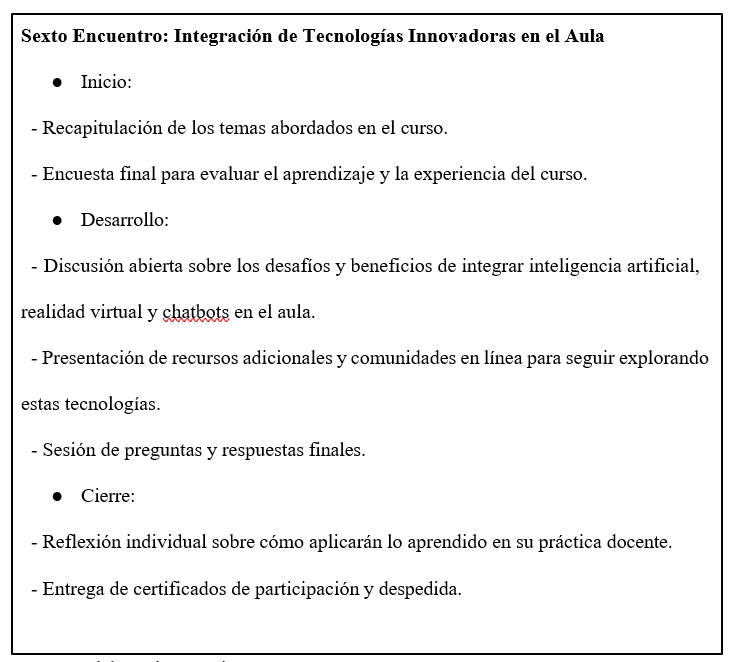
Figure 8. Meeting 6
PHASE 3: in a meeting with the Maryland Institution's management team, the intervention plan will be evaluated, a conclusion will be reached, and the next steps will be determined.
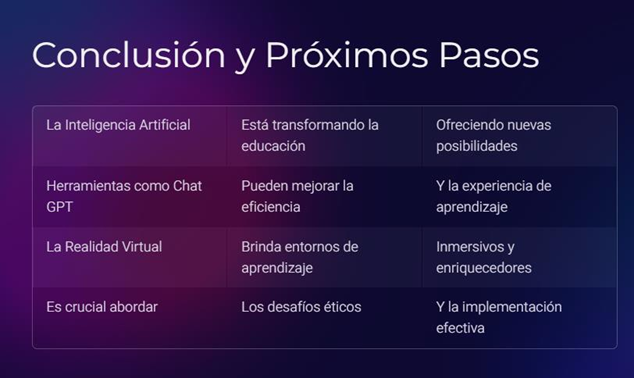
Figure 9. Conclusions and next steps
Schedule
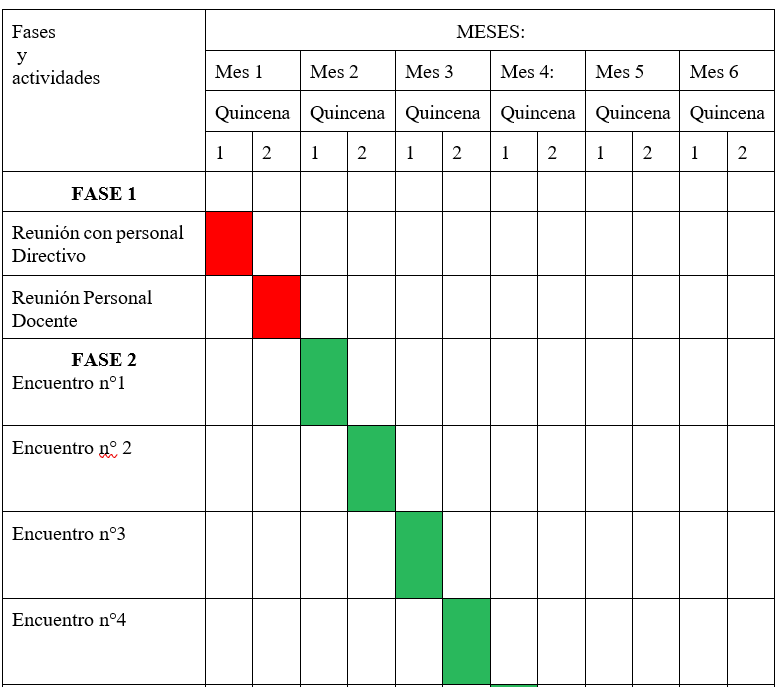
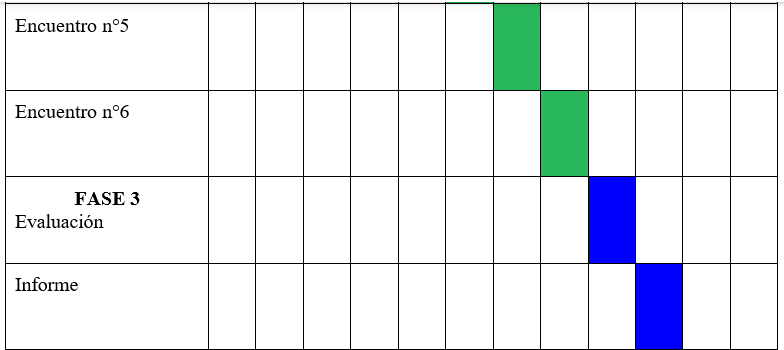

Figure 10. Schedule
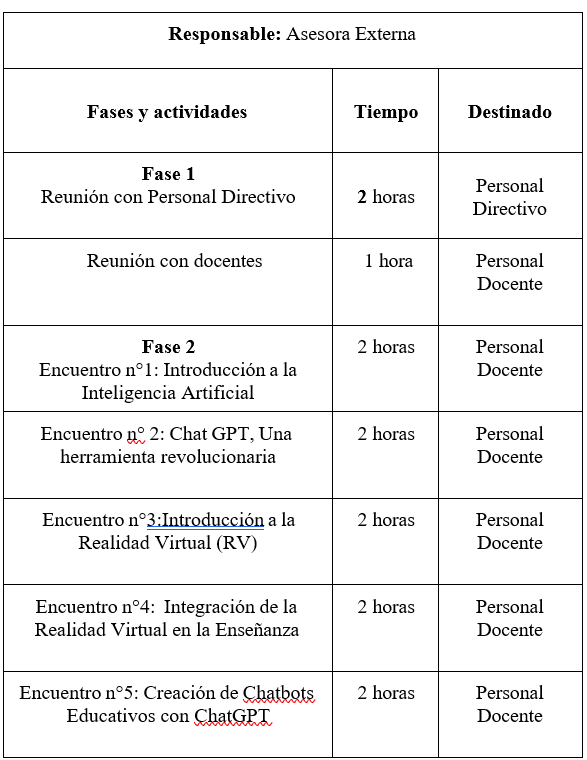
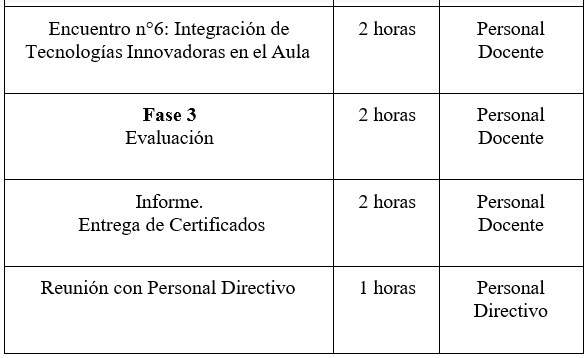
Figure 11. Hours and recipients
Resources
· Human resources: external educational advisor, administrators, teachers, teaching assistant.
· Technical resources: computers, cell phones, speakers, internet, projector (or TV and DVD player with USB). Internet access (or video on a USB flash drive).
· Material resources: physical space for the meeting. Whiteboard for presentation, chairs, tables, markers.
· Infrastructure resources: computer room.
· Financial resources: initially, the institution's own resources will be used.
Budget
Initially, the resources available at the Maryland Educational Unit will be used. The computer room, internet, speakers.
To enhance the virtual reality experience, virtual reality glasses may be used. The unit price is $7948. The budget obtained on the open market is as follows: https://www.mercadolibre.com.ar/anteojos-vr-box-realidad-virtual-lenses-3d-joystick-control-helmet-smartphone-for-mobile-entertainment-portable/p/MLA24386303?quantity=1
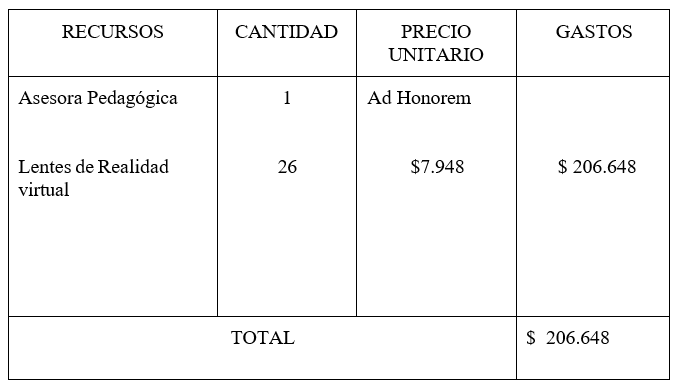
Figure 12. Budget
Evaluation
The evaluation consists of "a process of outlining, obtaining, processing, and providing valid, reliable, and timely information about the merit and value of a student's learning to make a value judgment that allows for various types of decisions to be made".(8)
During the different meetings, evaluation and socialization between teachers and the trainer will take place. Formative and summative assessments will be carried out to gather the information necessary to evaluate the education and training process. The review will be diagnostic, summative, and formative.
Diagnostic to determine the profile of teachers and identify needs. Formative: throughout the process to provide better feedback. Summative to determine results and assess the achievement of the teaching objective.
The training process will take into account how each teacher approached the activities carried out, their understanding of them, etc. Participation is crucial for obtaining the necessary feedback on the proposed work.
The assessment tools will be online forms using tools such as Google Forms, which allow for easy evaluation of the content. Another resource that will be used is online tests, using Quiziz.
Another tool that will be used is the attendance sheet, which will be available on the teachers' home pages.
RESULTS
Expected results
It is expected that with the intervention plan using communication technologies, applying Artificial Intelligence, both GPT chat and virtual reality, the expected objectives will be achieved, that teachers will acquire the skills to innovate education and provide students with the possibility of having an innovative experience, where they can create educational content and get help with private and practical tasks.
Teachers will easily assimilate the theoretical framework. This will facilitate their teaching tasks and enable them to offer their students the tools they need to apply and participate, thereby improving their academic trajectories and allowing them to immerse themselves in virtual environments to enhance their interactive learning experiences.
Using augmented reality, teachers and students will have a visual representation of abstract concepts, improving their understanding and assimilation.
CONCLUSIONS
ICT tools such as artificial intelligence, ChatGPT, and virtual reality used in the classroom innovate education and respond to students' needs. The use of ICT as innovative teaching tools achieves a varied and better quality of education.
Chat GPT plays a vital role in the classroom, acting as a digital assistant for teachers and students. By providing access to accurate information and explanations in an easy-to-understand format, this chatbot can significantly improve the learning experience.
Virtual reality simulators, which represent images or scenes, offer endless possibilities, as they allow users to dive into the sea to learn about marine biology, visit Ancient Rome to discover its customs and monuments, or become an astronaut and travel through space, all through applications. This increases motivation, curiosity, and learning among students.
In terms of limitations, chat cannot replace human interaction. Judgment and contextualization by the teacher or student are necessary, as criteria are needed to validate the information provided for it to be effective.
As for virtual reality, the institution has the necessary resources, as it has a computer room. The only suggestion is to purchase virtual reality glasses.
The integration of institutional actors, from administrators to students, in training on new technological innovations is a collective effort to create, enhance, and improve educational quality.
Once the intervention is complete, there is the possibility of integrating online communities to continue exploring these technologies and remain at the forefront of new technologies.
BIBLIOGRAPHIC REFERENCES
1. Universidad Siglo 21. Módulo 0. Plan estratégico: modelos de aprendizajes innovadores. 2019a. https://siglo21.instructure.com/courses/9629/pages/plan-de-intervencionmodulo-0#org0
2. Carbonel J. La aventura de innovar: el cambio en la escuela. Madrid: Ediciones Mora; 2001.
3. Fernández Navas M. Innovación educativa: más allá de la ficción. Madrid: Ediciones Pirámide; 2016.
4. Lévy P. Cibercultura: la cultura en la sociedad digital. Barcelona: Anthropos Editorial; 2007.
5. Sánchez V. Recursos Educativos Digitales. Smile and Learn; 2021.
6. Universidad Siglo 21. Módulo 0. P.I. Unidad Educativa Maryland. Lecciones: 1, 2, 3, 4, 5, 6, 8, 10, 11, 13, 14, 15 y 18. 2019b. https://siglo21.instructure.com/courses/9629/pages/plan-de-intervencion-modulo-0#org3.
7. Dussel I, Quevedo L. Educación y nuevas tecnologías: los desafíos pedagógicos ante el mundo digital. Documento Básico del VI Foro Latinoamericano de Educación. Buenos Aires: Santillana; 2010.
8. Ahumada P. La evaluación en una concepción de aprendizaje significativo. 2ª ed. Valparaíso: Ediciones Universitarias de Valparaíso; 2001.
9. Blázquez Sevilla A. Realidad aumentada en Educación. Licencia Creative Commons 3.0 Internacional; 2017.
10. Caldeiro G, Chamorro F, Gonzalez N, Kvitca A, Milillo C. Inteligencia artificial y aprendizaje activo: investigación y diseño de estrategias de enseñanza con IA en escuelas.
11. Freire Andrade P. Intervención educativa: ¿Qué es, cómo y para qué se hace? Aguascalientes: Universidad Pedagógica Nacional; 2009. http://www.upn011.edu.mx
12. Gamma.app. Inteligencia Artificial para Docentes. https://gamma.app/docs/Inteligencia-Artificial-para-Docentes-b4c5pmmnyskp2yq
13. InfoLEG. Ley de Educación Nacional. https://servicios.infoleg.gob.ar/infolegInternet/anexos/120000-124999/123542/norma.htm
14. UNESCO. Inteligencia artificial en la educación digital. https://www.unesco.org/es/digital-education/artificial-intelligence
15. UNESCO. Alfabetización: lo que hay que saber. https://www.unesco.org/es/literacy/need-know
16. Morduchowicz A, Suasnábar JM. ChatGPT y educación: ¿oportunidad, amenaza o desafío? Enfoque Educación. 2023. https://blogs.iadb.org/educacion/es/chatgpt-educacion/
FINANCING
None.
CONFLICT OF INTEREST
None.
AUTHORSHIP CONTRIBUTION
Conceptualization: Karina Alejandra Rissone, Mariana Arruabarrena Vittar.
Data curation: Karina Alejandra Rissone, Mariana Arruabarrena Vittar.
Formal analysis: Karina Alejandra Rissone, Mariana Arruabarrena Vittar.
Research: Karina Alejandra Rissone, Mariana Arruabarrena Vittar.
Methodology: Karina Alejandra Rissone, Mariana Arruabarrena Vittar.
Project management: Karina Alejandra Rissone, Mariana Arruabarrena Vittar.
Resources: Karina Alejandra Rissone, Mariana Arruabarrena Vittar.
Software: Karina Alejandra Rissone, Mariana Arruabarrena Vittar.
Supervision: Karina Alejandra Rissone, Mariana Arruabarrena Vittar.
Validation: Karina Alejandra Rissone, Mariana Arruabarrena Vittar.
Visualization: Karina Alejandra Rissone, Mariana Arruabarrena Vittar.
Writing – original draft: Karina Alejandra Rissone, Mariana Arruabarrena Vittar.
Writing – review and editing: Karina Alejandra Rissone, Mariana Arruabarrena Vittar.